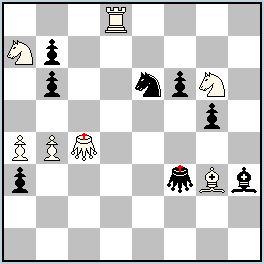No.502 by Neal Turner – This is the 2nd author’s problem with unusual combination of SAT and Royal Grasshoppers in s#2 published on JF (the previous one was in September,2013 – No.374). Enjoy a detailed comment by Neal, who believes that “this stuff is so unusual (I’m the only one doing it!) and so radically different from other kinds of orthodox/fairy chess that it seems to be necessary.“! (JV)
Definitions:
SAT: A king is in check if any of its flight squares are unguarded by opposing pieces.
Grasshopper(G): Moves along Q-lines over another unit of either color to the square immediately beyond that unit. A capture may be made on arrival, but the hurdle is not affected.
Royal piece: Piece that executes a function of the King on the board.
|
No.502 Neal Turner
Finland
original – 21.02.2014
 s#2 (7+8) s#2 (7+8)
SAT
Royal Grasshoppers c4, f3
1.Se7! (2.Sd5+ f5#)
1…rGf7 2.Sf5+ rGxa7#
1…Sf4 2.Bf2+ Bf1#
1…b5 2.Sec8+ b6#
(C+ by WinChloe 3.24 and Popeye 4.55-4.61, but no solutions by Py4.63,4.65)
Black’s only mobile pieces are the pawns on a3 & b6, while the main feature of the position is the mutual guard of f7 by the rGs.
So we have 3 effects from the threat move:
- cutting White’s guard of f7
- putting a guard on f6
- creating a new flight square for the wrG on e6
while the reply also has 3 effects:
- changing the flight on the f-file from the unguarded f7 to the guarded f6
- interfering with the bishop’s guard of e6,
- removing the brG’s guard of f7, so pinning the knight on d5
All these 6 effects are required for the threat to work.
In the diagram we see that the brG is prevented from moving to f7 because of checks on a7,f5 & h5 – the key move eliminates all of these!
After 1..rGf7 we want to move the Se7 and send the brG off to a7 leaving a check on f7.
We need a double check to get the required result, but after 2.Sg6/g8+ rGxa7+ White defends with 3.Rd5!!
So now it’s White’s turn to cut the bishop’s guard of e6, achieving the aim with 2.Sf5+.
The post-key guard of f5 also allows the black knight into the action – by vacating e6 he’s now guarding it.
But spotting the new flight on g4 guarded only by the enemy bishop, His Majesty cries out “Who will rid me of this meddlesome priest?” and his very own prelate is on hand to oblige with a stab in the back!
Black has one last trick up his sleeve.
1..b5 puts a guard on the wrG’s square allowing him to run to e6 after the check (exploiting yet another effect of 2..f5 – clearing the e6-g6 line).
In the set play we have two replies to this move: 2.Sac8+ b6# or 2.Ra8+ b6/rGxa8#, but after the key we get 2.Sac8+ rGf7! or 2.Ra8+ rGxa8+! 3.Sd5.
To prevent these defences we must again call upon the services of the key piece. (Author)
|
 s#2 (7+8)
s#2 (7+8)


It’s a fantastic mechanism. At first I wondered about the purpose of wSa7 and wBg3 (except being the hurdles), but a better look nicely justifies everything.
What is not clear from the definition, is a capture of a royal piece allowed?
No, kings and royal pieces cannot be captured. Usually it is not mentioned in any of the equivalent definitions of SAT (see below), but it is an important point.
SAT: Not frequently seen. Can we define this way? “A King is in check if it has any flight square”
There are a few equivalent definitions of SAT, all with the same point. It is a result of the SAT development history as Ladislav Salai sr. had first an idea and then, by trying different points he gradually developed various versions of SAT. (See e.g. this introduction at CCM.) Fortunately, SAT as we know it today is simply defined, because it allows motivation difficult to understand with standard chess background.
Generally speaking, SAT sems very confusing fairy condition at the first sight, but after getting used to it, multiple composers have found it manageable and productive. Of course both Salais (jr. and late sr.), but there are interesting works by many others – L. Kekely, V, Dyachuk, N. Turner, M. Caillaud, M. Rittirsch (and myself), altogether there are 31 different authors of SAT problems in the big WinChloe db. Some of them have even entered FIDE Albums. In my view the real breaktrough of the condition was a jubilee tourney Club Pongracz 10 in 2002, with two sections for standard SAT rules and SAT with additional fairy rules. Among recent works I found very instructive twomover by M. Caillaud with AUW:
Michel Caillaud
2nd Prize Club Pongracz 20 JT 2012
White : Ka3 Bf6a4 Sb4a2
Black : Kd2 Be1 Sa1 Pd5c3d3e3b2e2
#2 SAT (5+9)
Only two black pawns (b2, d5) can move, two white zugzwang tries are refuted uniquely (1.Bd4? b1Q! and 1.Bd8? d4!), therefore White creates threat:
1.Bh4! thr. 2.Bxd1#
1…b1Q 2.Sxc3# (2.Sxd3+? Qxd3!, 2.Sc1+ Qxc1!)
1…b1R 2.Sxd3#
1…b1B 2.Sc1#
1…b1S 2.Kb3# (promotion removes potential flight a3)
Neal has found long ago that royal grasshoppers are ideal for SAT problems as they have usually limited number of flights and moreover their flights are quite dynamic. As a result even s#2 can show very rich play.
Of course when I remarked that I was ‘the only one doing this stuff’ I didn’t mean I was the only one doing SAT – but I do believe I am the only one doing Two-move Selfmates with SAT & Royal Grasshoppers!
There’s an article in the pipeline (where it seems to have got stuck!) setting out my findings after more than 4 years in the Twilight Zone.
Oh no! Now I’ve mentioned this project I’m going to have complete it!